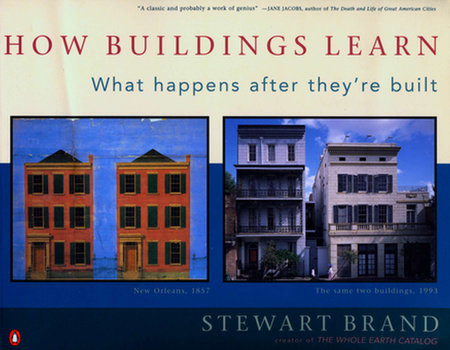Pages
▼
Wednesday, January 10, 2018
How Buildings Learn
Anyone interested in architecture should read this book by Stewart Brand. Brand won a National Book Award for the Whole Earth Catalog, and is a co-founder of Global Business Network, a futurist research organization fostering "the art of the long view." How Buildings Learn features a lot of illustrations and insights about building and buildings. I especially enjoy the comparison of two structures on the campus of MIT:
The legendary Building 20 (1943) was an artifact of wartime haste. Designed in an afternoon by MIT grad Don Whiston, it was ready for occupancy by radar researchers six months later... In an undertaking similar in scope to the Manhattan Project that created the atomic bomb, the emergency development of radar employed the nation's best physicists in an intense collaboration that changed the nature of science. Unlike Los Alamos, the MIT radar project was not run by the military, and unlike Los Alamos, no secrets got out. The verdict of scientists afterward was, "The atom bomb only ended the war. Radar won it." ... Author Fred Hapgood wrote in 1993 of Building 20, "The edifice is so ugly that it is impossible not to admire it, if that makes sense; it has ten times the righteous nerdly swagger of any other building on campus... Although Building 20 was built with the intention to tear it down after... World War II, it has remained... providing a special function... Not assigned to any one school, department, or center, it seems to always have had space for the beginning project, the graduate student's experiment, the interdisciplinary research center.
In a later chapter, Brand describes famous architect I.M. Pei's third MIT building, known informally as the Media Lab and formally as the Wiesner Building:
It may have been my familiarity with MIT's homely, accommodating Building 20 just across the street that made the $45 million pretentiousness, ill-functionality, and non-adaptability of the Media Lab building so shocking to me... Nowhere in the whole building is there a place for casual meetings, except for a tiny, overused kitchen. Corridors are narrow and barren. Getting new cabling through the interior concrete walls - a necessity in such a laboratory - requires bringing in jackhammers. You can't even move office walls around, thanks to the overhead fluorescent lights being at a Pei-signature 45-degree angle to everything else.
The Media Lab building, I discovered, is not unusually bad. Its badness is the norm in new buildings overdesigned by architects...
Brand finishes How Buildings Learn with a list of good books, writing, "They are the texts I would reach for if I was going to work on a building..."


No comments :
Post a Comment
Note: Only a member of this blog may post a comment.